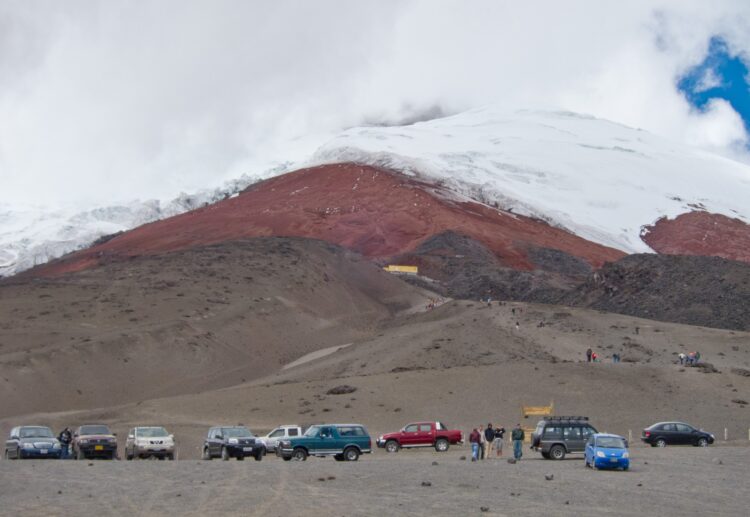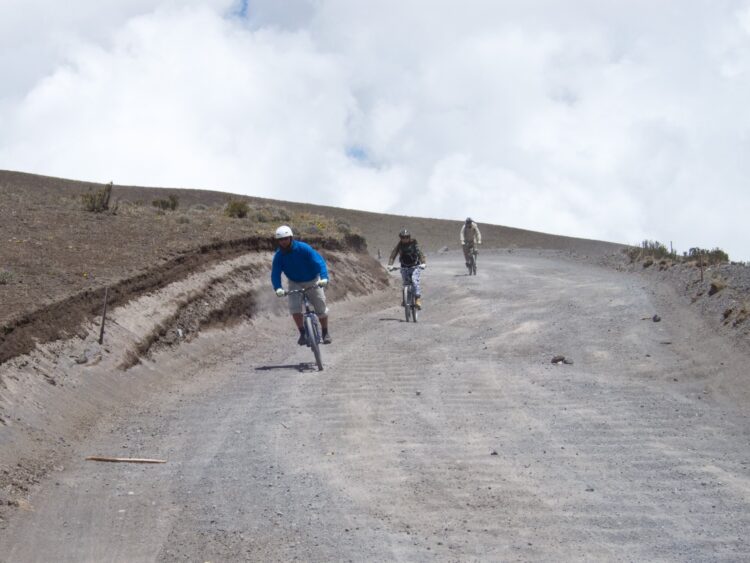
The parking lot at Cotopaxi Volcano – 4,500 meters above sea level
Mountain biking Cotopaxi Volcano was easily the most scenic, exciting bike ride of my life. And one of my favorite day trips, ever.
I first learned about this high-altitude adventure from Jack and Jill, in a story they wrote about activities that did NOT kill them in Ecuador.
Excellent.
But I had a few concerns before I'd be ready to sign up.
First, can I find a tour company that uses quality bikes, and keeps the brakes in good working condition?
Yes. After Googling around, I discovered several positive referrals for the Biking Dutchman, which has been running tours to Cotopaxi for an odd 25 years, before anyone else I'm sure.
And that's just one of many trips they run throughout the country (for more serious riders).

Welcome to Cotopaxi Volcano, Ecuador's second tallest at 5,897 meters.
And second, how would I feel at our drop-off point, 4,500 meters above sea level, when I was already having light headaches while acclimatizing to Quito's 2,800-meter elevation?
When I visited the Biking Dutchman's office, I was met by the daughter of the company's founder. Of course, she's taken the bike ride, and assured me it was no big deal.
And unlike other bike tours, their's was more focused on the bike riding and did not include the (strenuous) 300-meter walk up to the base camp used for summit attempts (aka the refuge).
In other words, we'd be driven up to the parking lot at 4,500 meters, and almost immediately beginning our descent.
So I paid a $10 deposit on the $59 tour (which included lunch).
My trip left the next day, a Saturday morning, which meant trying to get a good night's sleep in the hostel was near impossible.

The 4×4 we took to Cotopaxi
Table of Contents
How to Mountain Bike One of the World's Tallest Active Volcanoes
At 7 or 8 AM, I grabbed a quick breakfast at one of the few open restaurants in Plaza Foch and met up with the guides and our group for the day outside the Biking Dutchman's office.
We piled into two 4×4 trucks, with the mountain bikes on top, and drove about two hours through southern Quito to Cotopaxi National Park, stopping for snacks once along the way.
During the drive, I got to know some of the others in my truck.
Most were Americans, and there were even two older couples, one in their 40's, and one easily in their 50's. I admired their sense of adventure.
Once inside the park, we stopped at a rest area where I had the chance to drink my first coca leaf tea, which is suppose to help with the effects of high altitudes.
For $3 per cup, it better!

Geared up and ready to go downhill mountain biking
This was also where we were fitted with helmets, and given gloves, which are as much for warmth, as protecting our hands from the day's riding, and in the event, we should bite the dust on the rocky roads.
And then we began the ascent up the volcano to the parking lot at 4,500 meters.
The altitude was a new high for me, though it lacks the sense of accomplishment when you don't get there by trekking.
Our guide matched each person individually with a bike based on our heights, and then gave us a safety briefing, including tips for how to properly go mountain biking down Cotopaxi Volcano (or anywhere for that matter).

Downhill mountain biking Cotopaxi Volcano. This photo was shot just below the parking lot.
Tips for Mountain Biking Cotopaxi Volcano
- Use the back brake 70%, and the front brake 30%
- Don't mix up the brakes, because if you press the front only, you'll immediately fly over the handlebars
- Stand up, with the pedals parallel to the ground, your right (dominant) foot forward, and knees bent
- Lean your weight backward, especially on the steeper terrain
- It's better to allow the bike to gain some speed than to be riding the brakes hard the whole way (let the bike's front shock absorbers do their job, and you'll have a more comfortable ride)
And then we were off and riding down one of the world's tallest active volcanoes!
At first, I was riding the brakes pretty hard, however as I began to trust the bike more and more, I loosened up and did better maintaining a constant speed.
The road was very rutted, and keeping to the inner or outer edges often helped reduce the bumps.

Riding down Cotopaxi
Traffic continued to go up the road in the opposite direction, but it was slow enough that you always saw them coming, and could adjust your position and speed accordingly.
The main downhill portion runs eight kilometers from the parking lot to relatively flat terrain, and it's over pretty quick, even if you're stopping to take pictures along the way.
The sweeping views of the valley and nearby mountains were gorgeous, and our partly cloudy weather offered near-perfect conditions according to our guide.
Dressing in layers is essential, as you'll want to be warm at the top, while a t-shirt or long sleeve shirt is sufficient by the bottom.
Sunglasses are an absolute requirement due to the elevation, and reflection of the sun off the glacier.
Sunscreen is also a good idea.
One of the 4×4's was always behind our group in case someone needed a break, which was the case with the oldest woman on the downhill section.
Everyone else rode down without any trouble.

Cotopaxi Volcano as seen from about 3,800 meters. A little below the yellow “refuge” tent, you can see the parking lot
With the Biking Dutchman trips, you spend more time mountain biking Cotopaxi Volcano National Park after the downhill section, versus other trips which spend that time hiking to the refuge, and if possible, further up to the snowline.
The terrain in the valley may look flat, and easy to ride, but when you're pedaling at altitudes of 3,300-3,700 meters, it's still hard work.
Unless you want to be out of breath the whole time, it pays to keep a slow but steady pace.
Lunch at Laguna Limpiopungo
We enjoyed a lunch of pasta, and some kind of spinach pastry, overlooking Laguna Limpiopungo (3,830 meters).
The chocolate brownies for dessert were the bomb. And worth the price of the trip on their own.
Fresh ginger tea was served, a reminder of my time in Nepal.
Final Thoughts
Our mountain biking trip through Cotopaxi National Park concluded some 26-30 kilometers from where we started up on the volcano.
Toward the end, we passed wild horses grazing near the road.
Some sections were more fun to ride than others.
At times, I was surprised at how fast I'd be going over what appeared to be some very rough terrain.
Our guide was right about learning to trust our bikes — the more time I spent on it, the more I relaxed and enjoyed the bumps.
Storm clouds and lightning had begun to roll through the valley, and our guide wisely suggested we stop, whereas they usually allow riders to keep going for as long as they want.
I highly recommend mountain biking Cotopaxi Volcano to everyone, regardless of age, sex, or physical fitness.
Though it helps to be in good condition, the spirit of adventure will serve you just as well.

Don't let the flat ground deceive you, it was still a lot of work to pedal as we were over 3,000 meters in elevation the whole day
What You Need to Know
How Much: $59 + tip
Difficulty: Moderate
Where to Book: Most hostels and travel shops in Quito. I recommend the Biking Dutchman (La Pinta E 731 and Reina Victoria). They use Trek mountain bikes and maintain them well. Nobody in my group complained of bad brakes.
What to Bring: A daypack, supply of snacks and water (at least one liter, preferably two), sunglasses, sunscreen, several layers including a light jacket in case it rains. Extra cash for cocoa leaf tea ($3) and tipping the guide at the end.
_____
Editor's Note: This story was updated February 16, 2017 to reflect updated pricing and address of the tour company.
Dave is the Founder and Editor in Chief of Go Backpacking and Feastio. He's been to 66 countries and lived in Colombia and Peru. Read the full story of how he became a travel blogger.
Planning a trip? Go Backpacking recommends:
- G Adventures for small group tours.
- Hostelworld for booking hostels.

Gina Jensen
Saturday 26th of March 2016
About how many hours did it take you to ride down? I've been to Ecuador once before and will be going back this fall with some of my family. Do they have bikes for children?
Christen
Saturday 30th of May 2015
How much do you tip the guides? Are there other places you need to tip along the way?
Kenneth
Wednesday 9th of April 2014
Just signed up to do this bike tour with Biking Dutchman as well. I'm psyched.
Brandon Kober
Tuesday 26th of March 2013
Hello there! I adore your posts. They are so informative! I was wondering what time you arrived back in Quito from this daytrip. I am curious because I am considering doing the trip and trying to fit both it and the busride to Banos in one day. Thanks for any advice! Brandon Kober Canada
Dave
Tuesday 26th of March 2013
I don't remember exactly, probably late afternoon, as it wasn't dark when we got back to Plaza Foch (where the office is located).
I found the Cotopaxi biking to be tiring in itself. The bus ride to Banos was another 3-4 hours if I remember correctly, and also by itself, a bit tiring.
I'd recommend getting some rest after the bike ride, and then taking the bus to Banos in the morning.
Bart Scrivener
Friday 15th of February 2013
What is the nature of the trail? How steep is it? How rocky is it? How much speed does one build up? Is it a technical descent? Are you ever on singletrack, or always on a road? Is it twisting or relatively straight? Are there water crossings? Is there a choice of route? What kind of bikes does the Dutchman use? Do they have disc brakes? What was the biking like after the (short!) downhill?
Friendly note: The plural of brake is brakes, not brake's.
Dave
Friday 15th of February 2013
The trail is actually a dirt road, so it's quite wide, and only really steep in the first section when leaving the parking lot. Once you reach the bottom, then you may ride some lines that take you off the roads.
You can build up as much speed as you want. Our guide flew by us because he had the confidence and experience to do so. Most of the people in my group, myself included, were not serious mountain bike riders, so we went slower.
On the descent there are small rocks. I don't know how else to describe it. You're on a volcano, so think scree, but it's nothing an average adult or even a teen couldn't handle.
No, it's not a technical descent. There are more hairpin turns near the top, where it's steeper. As you go down, the distance between turns is longer, allowing you to gain more speed.
There were no water crossings. No, I believe all the tours take you down the road, though some may take different routes at the bottom. The pictures I included in the post show what it's like biking at the bottom of the volcano. It's flat, but the altitude is still high enough to make it challenging (especially if you're not acclimatized).
To find out more about the bikes, visit the Biking Dutchman website. If the info isn't there, you can email them.